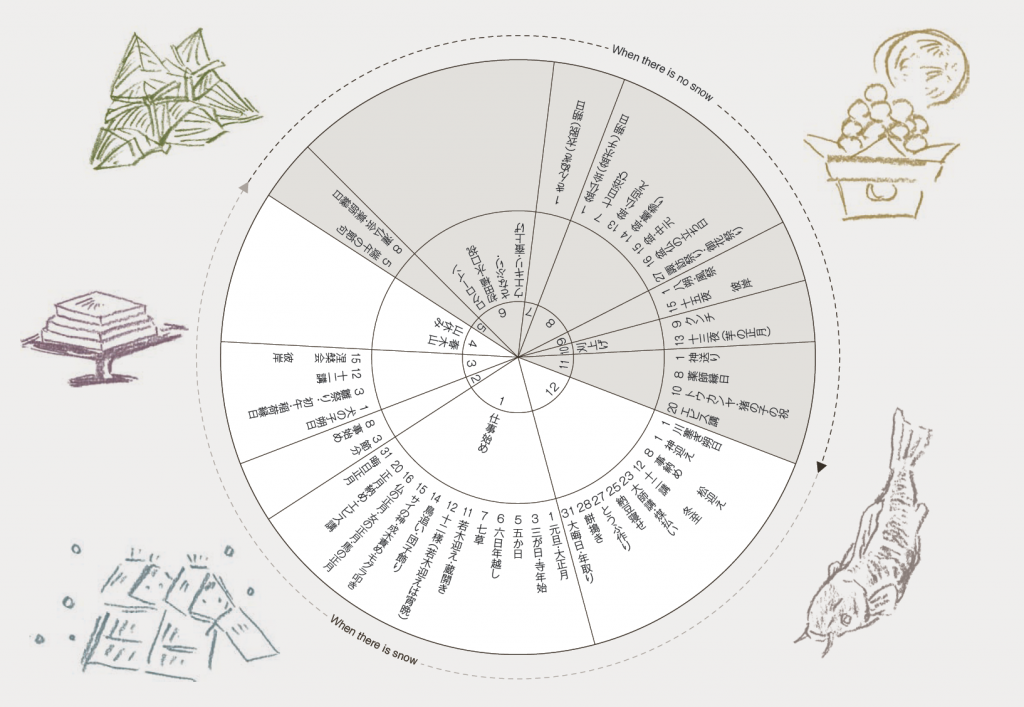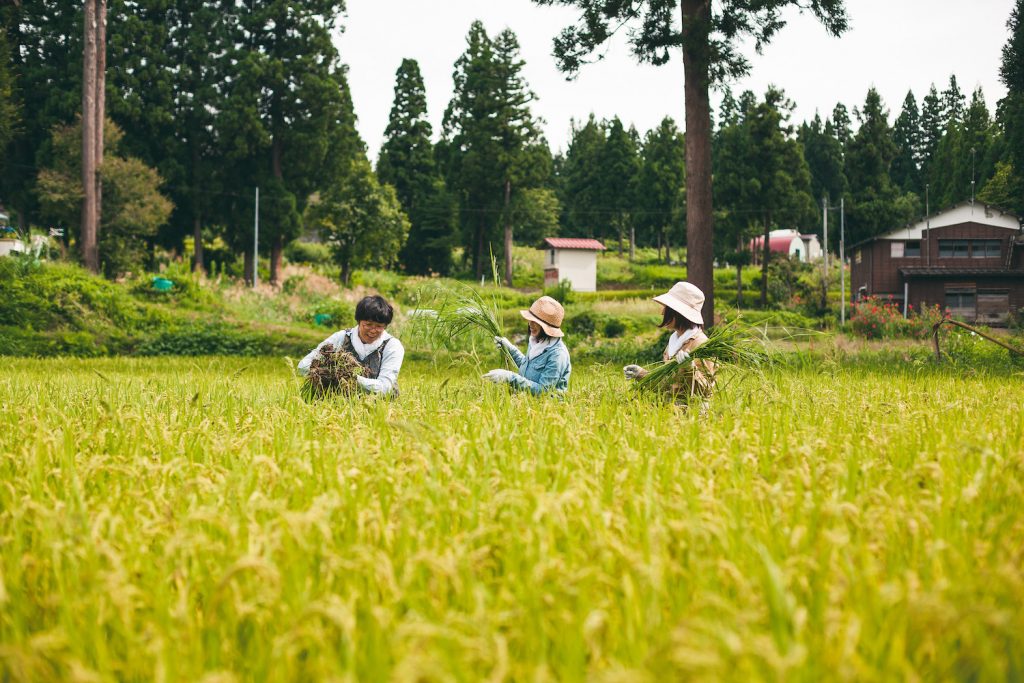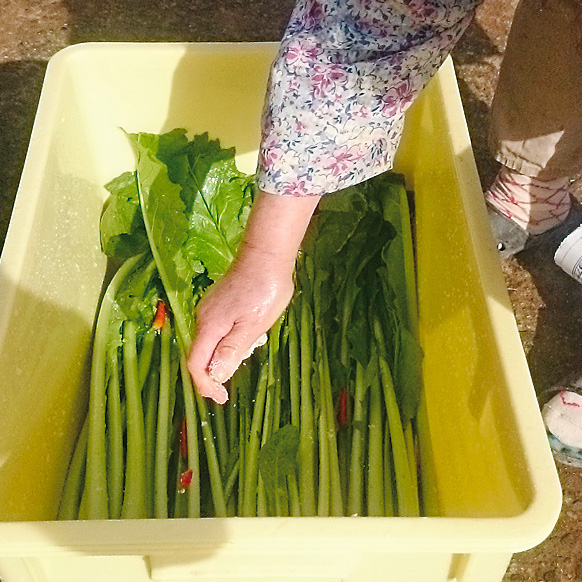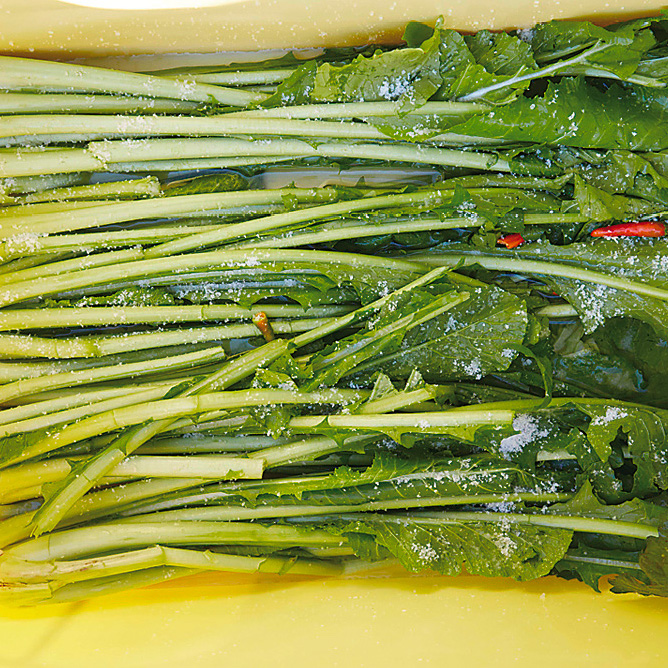
The picture above is a circular calendar showing events in YUKIGUNI, one of the heaviest snowfall areas in Japan. The numbers in the centre represent the months. As you can see, most of the events take place between December and March, when we live with the snow. And many of these events are related to food: food and culture are closely linked at YUKIGUNI.
Going back over 150 years from the present, you would find yourself in the Edo Period. What were the people living in YUKIGUNI eating at their celebrations back then?
In addition, many of the annual events on the calendar are about welcoming the gods into our homes and making offerings. As you know, there are traces of animism in Japan, and this is particularly evident in the Japanese countryside.
Rice is at the heart of Japan’s food culture
Rice is at the heart of Japanese food culture. Rice is said to be a versatile food that contains a diverse and balanced range of nutrients and has supported the lives of the Japanese people. YUKIGUNI is famous for producing Koshihikari, the most delicious rice in Japan.
There are many terraced rice fields in YUKIGUNI and many people come to see the beautiful scenery. However, because each rice field is small, it is difficult to mechanise and maintain. The farmers in this area have inherited the terraced rice fields that their ancestors worked so hard to cultivate, and grow rice in the traditional way. Planting the seedlings by hand, harvesting the rice, and hanging the harvested rice to dry on the terraces is quite hard work, but it gives the farmers a sense of oneness with the earth that modern people have forgotten.
Rice cultivation begins with the planting of rice in the spring, followed by weeding in the summer and the harvesting of rice in the autumn. Today, many farmers, even at YUKIGUNI, have introduced machines for planting and harvesting rice. These machines do a very precise job and it is never boring to watch them.
Heavy human labour in terraced rice paddies, and precise mechanical work in ordinary rice fields. Each type of rice production is adapted to the terrain and conditions, and the Japanese people are fundamentally grateful to the rice and the farmers who produce it.

It is possible to experience rice farming, the soul food of the Japanese people. One example is the farmhouse “Kayaya”. Here, if you book in advance, you can experience a variety of agricultural activities, such as harvesting seasonal vegetables and fruits. The photo shows us trying our hand at catching millet in the rice paddies.
It’s not easy, though. At first it is difficult to tell the difference between a rice plant and a millet because they look very similar. But don’t worry, your guide will show you how to tell them apart. It’s exhilarating to learn how they work and before you know it, you’ll be immersed in the experience.
Enjoying the YUKIGUNI gastronomy around the hearth.
After the farming experience, it’s time for dinner. Gather around the sunken hearth and enjoy the local cuisine made with YUKIGUNI ingredients. As the charcoal fire crackles in the hearth, you can enjoy a conversation with the owner about life in YUKIGUNI, satoyama and hunting. This is what YUKIGUNI gastronomy is all about: experiencing culture through food.

A thatched-roof guest house in the mountains. Surrounded by the forest, you can spend a relaxing time here.
The knowledge to make it through the winter.
The people who live in one of the world’s rarest snowfall areas have inherited the wisdom to live in harmony with the environment. Fermented food is one of these ways of surviving the winter. Fermented food is a source of pride and a source of gastronomy.

Imanari Pickle Shop has been in business for over 100 years and is certified as a A-grade Gourmet in YUKIGUNI. In 200 year old warehouse, local vegetables and wild vegetables are pickled using sake lees from the local sake, Hakkaisan. This is a traditional pickling method that has been handed down since the establishment of the brewery.
The rich aroma and smooth taste of the fermented food will fill your mouth. Because of the care taken, only a small amount can be made and it is not available in shops in Tokyo. It is a precious pickle that can only be found in shops in YUKIGUNI.
Nozawana pickles – Yukiguni’s home cooking
Fermented food made with nozawana is a family favourite of the people of YUKIGUNI. Everyone secretly thinks that this nozawana is the most delicious.

1. Harvesting Nozawana
Nozawana is harvested in November. In years when the first snow falls early, we sometimes harvest them in the snow. Once harvested, the nozawana is washed in water.

2. Pickling
Then, after arranging them in a container with salt and chilli, place a stone about twice the weight of the nozawana for a day to push out the water. Once the water has drained out, lighten the stone.

3. Leave to rest
Place the nozawana in a container and leave it in a cool place indoors until spring. In the spring they will ferment and become more sour and tasty.

4. Eat
It takes about 20 days to produce and can be eaten until May. It can be eaten as it is, but it can also be fried in oil or used as a garnish for bean jam. When the fermentation process has progressed and the Nozawana has become more sour, it is very good to cook it for a day and a night.
Different ways of preserving food
Fermented food with salt
Salted pickles are a common Japanese fermented food. In Niigata, facing the sea and blessed with an abundance of salt, pickling in salt was very popular. Miso-zuke is also good, the salty power of miso is useful for sterilisation and long lasting pickles. Vegetables pickled in miso are delicious with the umami flavour of miso.
Fermented food made with sake lees
Sake lees can be used to make fermented foods from the mountains, such as wild vegetables, or from the sea, such as baby sardines. This method is also popular in YUKIGUNI where there are many sake breweries.
Yukimuro (Snow storage)
It is also possible to store vegetables to last the winter by wrapping them in straw and storing them under the floor or out on the ground, or by building a small structure like the daikon tsugura. The area inside that is protected by the straw has the perfect temperature and humidity for storage, and vegetables kept inside are able to last the winter without freezing or losing their flavor.
It is also possible in large facilities that are using the technique of the yukimuro. Potatoes that have been stored in such a place get sweeter almost as if the sugar content has increased, and this effect has been demonstrated.
If you want to know more about Japanese food culture, read the story about the Zenmai (royal fern): the people of YUKIGUNI love wild vegetables, but the royal fern is the most precious, laborious and special of them all. A story about a little-known Japanese food culture.
Zenmai, The Secret Of Japan’s Undiscovered Food Culture
Satoyama is a treasure trove of mushrooms
YUKIGUNI’s satoyama is covered by a dense forest. Every year there is deep snow and the area is a treasure trove of wild vegetables in spring and mushrooms in autumn.
Wild mushrooms grow on beech trees that have fallen over. After they have just been toppled, kikurage are the first type to appear. After about 3 years nameko start to grow, and then when 5 or 6 years have passed bunaharidake and ezoharidake grow.
After 10 years have elapsed since the beech tree fell naraharidake will grow. Finding wild mushrooms takes lots of luck, but mushroom hunters will remember where beech trees have fallen and will know when each kind of mushroom will be likely to appear there. They will then go back to check.
There are many similarities between edible and poisonous mushrooms, and it takes about five years to be able to tell them apart. It is always advisable to go mushroom hunting with a expert guide.
If you want to know more about the deeper roots of Japanese food culture…
Things To Do
Gastronomy tours in Japan’s YUKIGUNI
Take a gastronomy tour to experience the blessings of the area with all five senses.
YUKIGUNI prepares for winter from spring to autumn because of its snowy and long winters. As a result of this, a rich knowledge of preservation, including fermented food, has been accumulated. YUKIGUNI Gastronomy Tours are an opportunity to immerse yourself in the unique food culture that emerges from this. YUKIGUNI is also famous for its sake, thanks to the abundance of pure water from the melting snow.


-1024x626-2.jpg)
